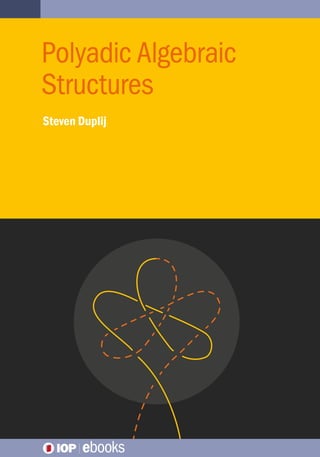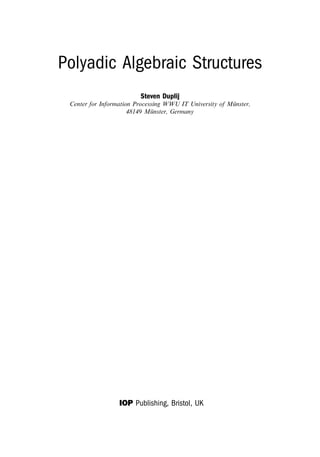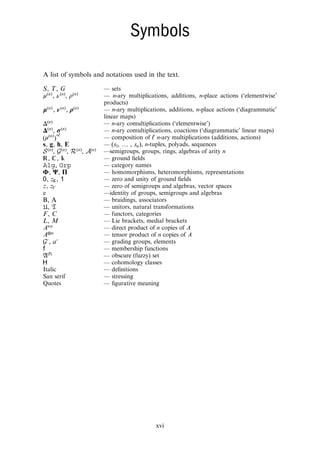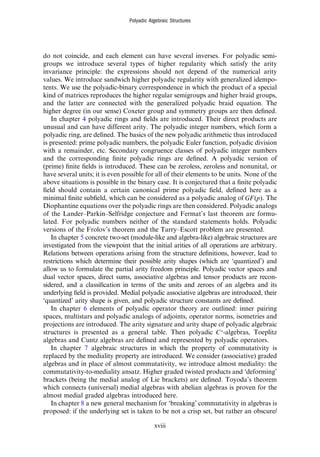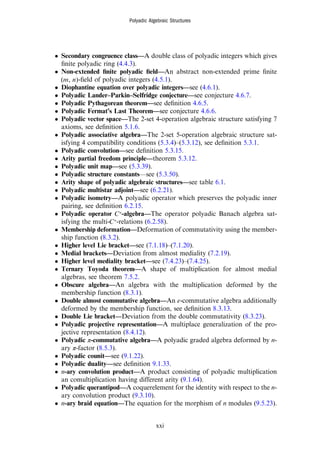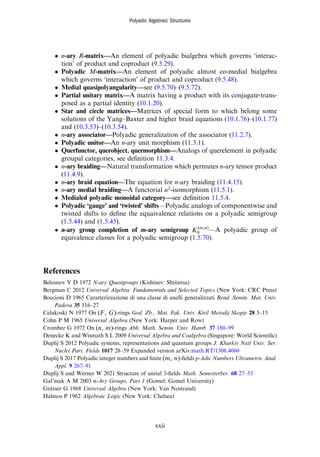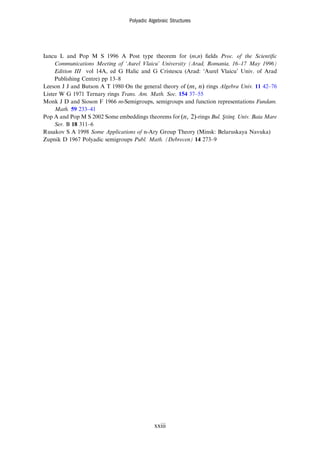Steven Duplij, "Polyadic Algebraic Structures", book Front matter
- 2. Polyadic Algebraic Structures Steven Duplij Center for Information Processing WWU IT University of Münster, 48149 Münster, Germany IOP Publishing, Bristol, UK
- 3. ª IOP Publishing Ltd 2022 All rights reserved. No part of this publication may be reproduced, stored in a retrieval system or transmitted in any form or by any means, electronic, mechanical, photocopying, recording or otherwise, without the prior permission of the publisher, or as expressly permitted by law or under terms agreed with the appropriate rights organization. Multiple copying is permitted in accordance with the terms of licences issued by the Copyright Licensing Agency, the Copyright Clearance Centre and other reproduction rights organizations. Permission to make use of IOP Publishing content other than as set out above may be sought at [email protected]. Steven Duplij has asserted his right to be identified as the author of this work in accordance with sections 77 and 78 of the Copyright, Designs and Patents Act 1988. ISBN 978-0-7503-2648-3 (ebook) ISBN 978-0-7503-2646-9 (print) ISBN 978-0-7503-2649-0 (myPrint) ISBN 978-0-7503-2647-6 (mobi) DOI 10.1088/978-0-7503-2648-3 Version: 20220601 IOP ebooks British Library Cataloguing-in-Publication Data: A catalogue record for this book is available from the British Library. Published by IOP Publishing, wholly owned by The Institute of Physics, London IOP Publishing, Temple Circus, Temple Way, Bristol, BS1 6HG, UK US Office: IOP Publishing, Inc., 190 North Independence Mall West, Suite 601, Philadelphia, PA 19106, USA
- 4. To my parents Lidia and Anatoliy Duplij who made many vital efforts in my formation and development for the book to be born, and to my wife Pierpaola whose everyday assistance, inspiration and general discussions allowed me to crystallize ideas and not be afraid of introducing new concepts.
- 5. Contents Preface xiii Acknowledgements xiv Author biography xv Symbols xvi Introduction xvii New constructions and ideas xx Part I One-set polyadic algebraic structures 1 One-set algebraic structures and Hosszú–Gluskin theorem 1-1 1.1 General properties of one-set one-operation polyadic structures 1-1 1.1.1 Changing arity of one-set polyadic algebraic structures 1-2 1.1.2 Special elements in one-set polyadic structures 1-5 1.2 Polyadic semigroups, quasigroups and groups 1-7 1.3 Polyadic direct products and changed arity powers 1-13 1.3.1 Polyadic products of semigroups and groups 1-13 1.3.2 Full polyadic external product 1-14 1.3.3 Mixed arity iterated product 1-15 1.3.4 Polyadic hetero product 1-17 1.4 The deformed Hosszú–Gluskin theorem 1-22 1.4.1 The Hosszú–Gluskin theorem 1-22 1.4.2 ‘Deformation’ of Hosszú–Gluskin chain formula 1-29 1.4.3 Generalized ‘deformed’ version of the homomorphism theorem 1-39 1.5 Polyadic analog of Grothendieck group 1-40 1.5.1 Grothendieck group of commutative monoid 1-40 1.5.2 The n-ary group completion of m-ary semigroup 1-44 References 1-60 2 Representations and heteromorphisms 2-1 2.1 Homomorphisms of one-set polyadic algebraic structures 2-1 2.2 Heteromorphisms of one-set polyadic algebraic structures 2-3 2.2.1 Multiplace mappings and heteromorphisms 2-3 2.2.2 Heteromorphisms and associativity quivers 2-9 vii
- 6. 2.3 Hetero-covering of algebraic structures 2-13 2.4 Multiplace representations of polyadic algebraic structures 2-16 2.5 k-Place actions 2-21 2.5.1 k-Place actions and G-spaces 2-21 2.5.2 Regular k-place actions 2-24 References 2-27 3 Polyadic semigroups and higher regularity 3-1 3.1 Generalized q-regular elements in semigroups 3-1 3.1.1 Binary q-regular single elements 3-2 3.1.2 Polyadic q-regular single elements 3-3 3.2 Higher q-inverse semigroups 3-7 3.2.1 Higher q-regular semigroups 3-8 3.2.2 Idempotents and higher q-inverse semigroups 3-13 3.3 Higher q-inverse polyadic semigroups 3-14 3.3.1 Higher q-regular polyadic semigroups 3-14 3.3.2 Sandwich polyadic q-regularity 3-18 3.3.3 Sandwich regularity with generalized idempotents 3-23 3.4 Polyadic-binary correspondence, regular semigroups, braid groups 3-26 3.4.1 Polyadic-binary correspondence 3-26 3.4.2 Ternary matrix group corresponding to the regular semigroup 3-27 3.4.3 Polyadic matrix semigroup corresponding to the higher regular semigroup 3-29 3.4.4 Ternary matrix group corresponding to the braid group 3-33 3.4.5 Ternary matrix generators 3-35 3.4.6 Generated n-ary matrix group corresponding the higher braid group 3-37 References 3-47 4 Polyadic rings, fields and integer numbers 4-1 4.1 One-set polyadic ‘linear’ structures 4-2 4.1.1 Polyadic distributivity 4-2 4.1.2 Polyadic rings and fields 4-3 4.2 Polyadic direct products of rings and fields 4-9 4.2.1 External direct product of binary rings 4-10 4.2.2 Full polyadic external direct product of m n ( , )-rings 4-11 Polyadic Algebraic Structures viii
- 7. 4.2.3 Mixed arity iterated product of m n ( , )-rings 4-12 4.2.4 Polyadic hetero product of m n ( , )-fields 4-15 4.3 Polyadic integer numbers 4-19 4.3.1 Congruence classes and operations 4-19 4.3.2 Polyadic rings in limiting cases 4-24 4.3.3 Prime polyadic integers 4-27 4.3.4 The mapping of parameters to arity 4-33 4.4 Finite polyadic rings of integers 4-35 4.4.1 Secondary congruence classes 4-35 4.4.2 Finite polyadic rings of secondary classes 4-36 4.5 Finite polyadic fields of integer numbers 4-39 4.5.1 Abstract finite polyadic fields 4-39 4.5.2 Multiplicative structure of finite polyadic fields 4-41 4.5.3 Examples of exotic finite polyadic fields 4-50 4.6 Diophantine equations over polyadic integers and Fermat’s theorem 4-52 4.6.1 Polyadic analog of the Lander–Parkin–Selfridge conjecture 4-53 4.6.2 Frolov’s theorem and the Tarry–Escott problem 4-59 References 4-61 Part II Two-sets polyadic algebraic structures 5 Polyadic algebras and deformations 5-1 5.1 Two-set polyadic structures 5-1 5.1.1 Polyadic vector spaces 5-1 5.1.2 One-set polyadic vector space 5-7 5.2 Mappings between polyadic vector spaces 5-8 5.2.1 Polyadic functionals and dual polyadic vector spaces 5-10 5.2.2 Polyadic direct sum and tensor product 5-13 5.3 Polyadic associative algebras 5-17 5.3.1 ‘Elementwise’ description 5-17 5.3.2 Polyadic analog of the functions on group 5-24 5.3.3 ‘Diagrammatic’ description 5-26 5.3.4 Medial map and polyadic permutations 5-30 5.3.5 Tensor product of polyadic algebras 5-33 5.3.6 Heteromorphisms of polyadic associative algebras 5-34 5.3.7 Structure constants 5-36 References 5-38 Polyadic Algebraic Structures ix
- 8. 6 Polyadic inner spaces and operators 6-1 6.1 Polyadic inner pairing spaces and norms 6-1 6.2 Elements of polyadic operator theory 6-6 6.2.1 Multistars and polyadic adjoints 6-8 6.2.2 Polyadic isometry and projection 6-14 6.2.3 Towards a polyadic analog of * C -algebras 6-16 References 6-19 7 Medial deformation of n-ary algebras 7-1 7.1 Almost commutative graded algebra 7-2 7.1.1 Almost commutativity 7-3 7.1.2 Tower of higher level commutation brackets 7-5 7.2 Almost medial graded algebras 7-7 7.2.1 Medial binary magmas and quasigroups 7-7 7.2.2 Almost mediality 7-8 7.2.3 Tower of higher binary mediality brackets 7-11 7.3 Medial n-ary algebras 7-13 7.4 Almost medial n-ary graded algebras 7-14 7.4.1 Higher level mediality n2-ary brackets 7-18 7.5 Toyoda’s theorem for almost medial algebras 7-20 References 7-21 8 Membership deformations and obscure n-ary algebras 8-1 8.1 Graded algebras and Shur factors 8-1 8.2 Membership function and obscure algebras 8-3 8.3 Membership deformation of commutativity 8-4 8.3.1 Deformation of commutative algebras 8-4 8.3.2 Deformation of almost-commutative algebras 8-7 8.3.3 Double almost-Lie algebras 8-9 8.4 Projective representations 8-10 8.4.1 Binary projective representations 8-10 8.4.2 n-Ary projective representations 8-12 8.5 n-ary double commutative algebras 8-14 8.5.1 n-ary almost-commutative algebras 8-14 8.5.2 Membership deformed n-ary algebras 8-18 8.6 Conclusions 8-21 References 8-21 Polyadic Algebraic Structures x
- 9. Part III Polyadic quantum groups 9 Polyadic Hopf algebras 9-1 9.1 Polyadic coalgebras 9-2 9.1.1 Polyadic comultiplication 9-3 9.1.2 Homomorphisms of polyadic coalgebras 9-8 9.1.3 Tensor product of polyadic coalgebras 9-8 9.1.4 Polyadic coalgebras in the Sweedler notation 9-9 9.1.5 Polyadic group-like and primitive elements 9-11 9.1.6 Polyadic analog of duality 9-13 9.1.7 Polyadic convolution product 9-15 9.2 Polyadic bialgebras 9-22 9.3 Polyadic Hopf algebras 9-25 9.4 Ternary examples 9-31 9.4.1 Ternary Sweedler Hopf algebra 9-31 9.4.2 Ternary quantum group examples 9-32 9.5 Polyadic almost co-commutativity and co-mediality 9-34 9.5.1 Quantum Yang–Baxter equation 9-34 9.5.2 ′ n -Ary braid equation 9-37 9.5.3 Polyadic almost co-commutativity 9-39 9.5.4 Equations for the ′ n -ary R-matrix 9-40 9.5.5 Polyadic triangularity 9-42 9.5.6 Almost co-medial polyadic bialgebras 9-43 9.5.7 Equations for the M-matrix 9-46 9.5.8 Medial analog of triangularity 9-50 References 9-52 10 Solutions to higher braid equations 10-1 10.1 Yang–Baxter operators 10-1 10.1.1 Yang–Baxter maps and braid group 10-1 10.1.2 Constant matrix solutions to the Yang–Baxter equation 10-2 10.1.3 Partial identity and unitarity 10-4 10.1.4 Permutation and parameter-permutation 4-vertex Yang–Baxter maps 10-6 10.1.5 Group structure of 4-vertex and 8-vertex matrices 10-8 10.1.6 Star 8-vertex and circle 8-vertex Yang–Baxter maps 10-16 10.1.7 Triangle invertible 9- and 10-vertex solutions 10-19 Polyadic Algebraic Structures xi
- 10. 10.2 Polyadic braid operators and higher braid equations 10-22 10.3 Solutions to the ternary braid equations 10-24 10.3.1 Constant matrix solutions 10-24 10.3.2 Permutation and parameter-permutation 8-vertex solutions 10-27 10.3.3 Group structure of the star and circle 8-vertex matrices 10-30 10.3.4 Group structure of the star and circle 16-vertex matrices 10-35 10.3.5 Pauli matrix presentation of the star and circle 16-vertex constant matrices 10-38 10.3.6 Invertible and non-invertible 16-vertex solutions to the ternary braid equations 10-39 10.3.7 Higher 2n -vertex constant solutions to n-ary braid equations 10-42 References 10-43 Part IV Polyadic categories 11 Polyadic tensor categories 11-1 11.1 Binary tensor categories 11-1 11.2 Polyadic tensor categories 11-6 11.2.1 Polyadic semigroupal categories 11-7 11.2.2 n-Ary coherence 11-8 11.3 Polyadic units, unitors and quertors 11-9 11.3.1 Polyadic monoidal categories 11-10 11.3.2 Polyadic nonunital groupal categories 11-11 11.4 Braided tensor categories 11-13 11.4.1 Braided binary tensor categories 11-13 11.4.2 Braided polyadic tensor categories 11-16 11.5 Medialed polyadic tensor categories 11-20 11.5.1 Medialed binary and ternary categories 11-22 11.6 Conclusions 11-25 References 11-26 Polyadic Algebraic Structures xii
- 11. Preface Nowadays, the arity of algebraic structures tends to be investigated from either a too general (e.g., in abstract algebra, as sets with operations of arbitrary arity satisfying axioms), or a too narrow (e.g., in physics, as group-like, ring-like and algebra-like concrete structures with mostly binary operations) point of view. This book can be treated as a ‘bridge’ between these approaches. We propose using a full ‘polyadization’ procedure: take a concrete structure with binary operations and ‘free-up’ all arities while saving the ‘interaction’ between them. The latter gives equations relating arities, and since these are integers, we obtain ‘quantization’ rules for algebraic structures, restricting their arity shape. Another feature of this thorough ‘polyadization’ is the appearance of exotic properties which are not possible for binary arities, e.g., polyadic groups without identity and polyadic fields without zero. Another unusual possibility is mappings between structures of different arities, or heteromorphisms. This leads to a new kind of representation theory, in which the arity of an algebraic structure need not coincide with the arity of a representation. Further, new quantum groups, higher braidings, M-matrices and medialed categories are introduced. The book contains original constructions and ideas developed by the author, while known material is given in brief for notational purposes only. It should attract the attention of researchers in modern theoretical physics and mathematics who are interested in new directions and developments. Steven Duplij Münster, Germany December 2021 xiii
- 12. Acknowledgements The author is deeply grateful to Vladimir Akulov, Bernd Billhardt, Andrzej Borowiec, Andrew Bruce, Vesna Celakoska, Miroslav Ćirić Joachim Cuntz, Costantino Delizia, Christopher Deninger, Branko Dragovich, Wieslaw Dudek, Siegfried Echterhoff, Murray Geshtenhaber, Nick Gilbert, Gerald Goldin, Mike Hewitt, Lacrimioara Iancu, Vladimir Kalashnikov, Richard Kerner, Maurice Kibler, Mikhail Krivoruchenko, Grigorij Kurinnoj, Michel Lapidus, Dimitrij Leites, Daniel Lenz, Jerzy Lukierski, Yuri Manin, Riivo Must, Chi-Keung Ng, Peter Nonnenmann, Thomas Nordahl, Wolfram Von Oertzen, Valentin Ovsienko, Walther Paravicini, Christopher Phillips, Norbert Ponchin, Maria Pop, Vasile Pop, Sergey Prokushkin, Anatoliy Prykarpatsky, Ioan Purdea, Mathias Pütz, Dominik Rudolph, Jim Stasheff, Vladimir Tkach, Ron Umble, Raimund Vogl, Thomas Timmermann, Alexander Voronov, Raimar Wulkenhaar, and Wend Werner for fruitful discussions, important help and valuable support. xiv
- 13. Author biography Steven Duplij Steven Duplij (Stepan Douplii) is a theoretical and mathematical physicist from the University of Münster, Germany. He was born in Chernyshevsk–Zabaikalsky, Russia, and studied at Kharkiv University, Ukraine where he gained his PhD in 1983. While working at Kharkiv he received the title Doctor of Physical and Mathematical Sciences by Habilitation in 1999. Dr Duplij is the editor-compiler of ‘Concise Encyclopedia of Supersymmetry’ (2005, Springer), and is the author of more than a hundred scientific publications and several books. He is listed in the World Directory Of Mathematicians, Marques Who Is Who In America, the Encyclopedia of Modern Ukraine, the Academic Genealogy of Theoretical Physicists and the Mathematics Genealogy Project. His scientific directions include supersymmetry and quantum groups, advanced algebraic structures, gravity and nonlinear electrodynamics, constrained systems and quantum computing. xv
- 14. Symbols A list of symbols and notations used in the text. S T G , , — sets μ ν ρ , , n n n ( ) ( ) ( ) — n-ary multiplications, additions, n-place actions (‘elementwise’ products) μ ν ρ , , n n n ( ) ( ) ( ) — n-ary multiplications, additions, n-place actions (‘diagrammatic’ linear maps) Δ n ( ) — n-ary comultiplications (‘elementwise’) σ Δ , n n ( ) ( ) — n-ary comultiplications, coactions (‘diagrammatic’ linear maps) μ ◦ ( ) n ℓ ( ) — composition of ℓ n-ary multiplications (additions, actions) s g h E , , , — … s s ( , , ) n 1 , n-tuples, polyads, sequences , , , n n n n ( ) ( ) ( ) ( ) S G R A —semigroups, groups, rings, algebras of arity n , , — ground fields , Alg Grp — category names Φ Ψ Π , , — homomorphisms, heteromorphisms, representations z , , K 0 1 — zero and unity of ground fields z z , V — zero of semigroups and algebras, vector spaces e —identity of groups, semigroups and algebras B, A — braidings, associators , U T — unitors, natural transformations F C , — functors, categories L M , — Lie brackets, medial brackets × A n — direct product of n copies of A ⊗ A n — tensor product of n copies of A ′ ′ a , G — grading groups, elements f — membership functions ( ) A f — obscure (fuzzy) set H — cohomology classes Italic — definitions San serif — stressing Quotes — figurative meaning xvi
- 15. Introduction The study of polyadic (or higher arity) algebraic structures has a two-century long history, commencing with works by Cayley, Sylvester, Kasner, Prüfer, Dörnte, Lehmer, Post, etc. They took a single set, closed under one (main) binary operation having special properties (the so-called ’group-like’ structure), and ‘generalized’ it by increasing the arity of that operation, which can then be called a polyadic operation and the corresponding algebraic structure polyadic. We will use the term ‘polyadic’ in this sense only, while other uses are extantintheliterature(see,e.g.,Halmos1962).An‘abstractway’tostudypolyadicalgebraic structures is via theuse of universalalgebras definedas sets with various axioms(equational laws) for the polyadic operations (Cohn 1965, Grätser 1968, Bergman 2012). However, some important algebraic structures cannot be described in this language, e.g., ordered groups, fields, etc (Denecke and Wismath 2009). It is therefore also worthwhile to pursue a ‘concrete approach’ by studying examples of binary algebraic structures and then to ‘polyadize’ them in the proper way. This method has initiated the development of a corresponding theory of n-ary quasigroups (Belousov 1972), n-ary semigroups (Monk and Sioson 1966, Zupnik 1967) and n-ary groups (Gal’mak 2003, Rusakov 1998) (for a more recent review, see, e.g., Duplij 2012 and a comprehensive list of references therein). Binary algebraic structures with two operations (addition and multiplication) on one set (the so- called’ring-like’structures)werelatergeneralizedto m n ( , )-rings(Celakoski1977,Crombez 1972, Leeson and Butson 1980) and m n ( , )-fields (Iancu and Pop 1996) (for a recent study, see Duplij 2017), while these were mostly investigated in a more restrictive manner by considering particular cases: ternary rings (or (2, 3)-rings) (Lister 1971), m ( , 2)-rings (Boccioni 1965, Pop and Pop 2002), as well as (3, 2)-fields (Duplij and Werner 2021). In chapter 1 one-set polyadic algebraic structures are reviewed and their classification is given. The general ways of changing arity and special elements are considered. Polyadic direct products of (semi)groups which can change arity are then introduced. A new form of the Hosszú–Gluskin theorem is presented in terms of polyadic powers and using the language of diagrams. It is shown that the Hosszú– Gluskin chain formula is not unique and can be ‘deformed’ using a parameter q which takes special integer values, which leads to the concept of a sandwich nonunital endomorphism. The ‘q-deformed’ analog of the Hosszú–Gluskin theorem is then formulated, and a ‘q-deformed’ homomorphism theorem is given. Then we generalize the Grothendieck construction of the completion group for a monoid (being the starting point of the algebraic K-theory) to the polyadic case, when an initial semigroup in m-ary and the corresponding final class group K m n 0 ( , ) can be n-ary. In chapter 2 a new multiplace generalization of associativity preserving homo- morphisms, a ‘heteromorphism’ which connects polyadic systems having unequal arities, is introduced via an explicit formula, together with related definitions for multiplace representations and multiactions. The classification of heteromorphisms is given, and it is seen that their arity are not arbitrary, but ‘quantized’. Then regular multiactions are introduced and the corresponding regular multiplace representations are defined. In chapter 3 the regularity concept for semigroups is generalized in two ways simultaneously: to higher regularity and to higher arity. We show that in this approach the one-relational and multi-relational formulations of higher regularity xvii
- 16. do not coincide, and each element can have several inverses. For polyadic semi- groups we introduce several types of higher regularity which satisfy the arity invariance principle: the expressions should not depend of the numerical arity values. We introduce sandwich higher polyadic regularity with generalized idempo- tents. We use the polyadic-binary correspondence in which the product of a special kind of matrices reproduces the higher regular semigroups and higher braid groups, and the latter are connected with the generalized polyadic braid equation. The higher degree (in our sense) Coxeter group and symmetry groups are then defined. In chapter 4 polyadic rings and fields are introduced. Their direct products are unusual and can have different arity. The polyadic integer numbers, which form a polyadic ring, are defined. The basics of the new polyadic arithmetic thus introduced is presented: prime polyadic numbers, the polyadic Euler function, polyadic division with a remainder, etc. Secondary congruence classes of polyadic integer numbers and the corresponding finite polyadic rings are defined. A polyadic version of (prime) finite fields is introduced. These can be zeroless, zeroless and nonunital, or have several units; it is even possible for all of their elements to be units. None of the above situations is possible in the binary case. It is conjectured that a finite polyadic field should contain a certain canonical prime polyadic field, defined here as a minimal finite subfield, which can be considered as a polyadic analog of GF p ( ). The Diophantine equations over the polyadic rings are then considered. Polyadic analogs of the Lander–Parkin–Selfridge conjecture and Fermat’s last theorem are formu- lated. For polyadic numbers neither of the standard statements holds. Polyadic versions of the Frolov’s theorem and the Tarry–Escott problem are presented. In chapter 5 concrete two-set (module-like and algebra-like) algebraic structures are investigated from the viewpoint that the initial arities of all operations are arbitrary. Relations between operations arising from the structure definitions, however, lead to restrictions which determine their possible arity shapes (which are ‘quantized’) and allow us to formulate the partial arity freedom principle. Polyadic vector spaces and dual vector spaces, direct sums, associative algebras and tensor products are recon- sidered, and a classification in terms of the units and zeroes of an algebra and its underlying field is provided. Medial polyadic associative algebras are introduced, their ‘quantized’ arity shape is given, and polyadic structure constants are defined. In chapter 6 elements of polyadic operator theory are outlined: inner pairing spaces, multistars and polyadic analogs of adjoints, operator norms, isometries and projections are introduced. The arity signature and arity shape of polyadic algebraic structures is presented as a general table. Then polyadic * C -algebras, Toeplitz algebras and Cuntz algebras are defined and represented by polyadic operators. In chapter 7 algebraic structures in which the property of commutativity is replaced by the mediality property are introduced. We consider (associative) graded algebras and in place of almost commutativity, we introduce almost mediality: the commutativity-to-mediality ansatz. Higher graded twisted products and ‘deforming’ brackets (being the medial analog of Lie brackets) are defined. Toyoda’s theorem which connects (universal) medial algebras with abelian algebras is proven for the almost medial graded algebras introduced here. In chapter 8 a new general mechanism for ‘breaking’ commutativity in algebras is proposed: if the underlying set is taken to be not a crisp set, but rather an obscure/ Polyadic Algebraic Structures xviii
- 17. fuzzy set, the membership function, reflecting the degree of truth that an element belongs to the set, can be incorporated into the commutation relations. Special ‘deformations’ of commutativity and almost commutativity are introduced in such a way that equal degrees of truth result in the ‘nondeformed’ case. We also sketch how to ‘deform’ ε-Lie algebras and Weyl algebras and introduce the double almost-Lie algebras. Further, the above constructions are extended to n-ary algebras for which the analogs of projective representations and ε-commutativity are studied. In chapter 9 generalized polyadic coassociative coalgebras, bialgebras and Hopf algebras are defined and investigated. They have many unusual features in comparison with the binary case. For instance, both the algebra and its underlying field can be zeroless and nonunital, the existence of the unit and counit is not obligatory, while the dimension of the algebra is not arbitrary, but ‘quantized’. The polyadic convolution product and bialgebra can be defined, and when the algebra and coalgebra have unequal arities, the polyadic version of the antipode, the querantipode, has different properties. We introduce the polyadic version of braidings, almost co-commutativity, quasitriangularity and the equations for the R-matrix (which can be treated as a polyadic analog of the Yang–Baxter equation). We propose another concept of deformation which is governed not by the twist map, but by the medial map. We present the corresponding braidings, almost co-mediality and M-matrix (the medial analog of the R-matrix), for which compatibility equations are found. In chapter 10 constant matrix solutions of the polyadic (higher) braid equations are introduced and studied. They play a role as various quantum gates in quantum computation. We define two classes of 8-vertex matrices, star and circle, such that the magic matrices (connected with the Cartan decomposition) belong to the star class. We also define partial identity and unitarity. The general algebraic structure of the classes is described in terms of new semigroups, ternary and 5-ary groups and modules. We present the invertible and noninvertible 8-, 9- and 10-vertex Yang– Baxter maps. We then introduce polyadic braid operators for higher braid equations, find constant matrix solutions for the ternary 8- and 16-vertex cases and give their Pauli matrix presentation. In chapter 11 we generalize tensor categories and braided tensor categories using the commutativity-to-mediality ansatz, as in chapter 7 for algebras. A polyadic (non-strict) tensor categoryhas an n-ary tensorproduct asan additional multiplication with − n 1associators of the arity − n 2 1satisfying a + n ( 1) 2 -gon relation, which is a polyadic analog of the pentagon axiom. Polyadic monoidal categories may contain several unit objects, and it is also possible that all objects are units. A new kind of polyadic categories (called groupal) is defined: they are close to monoidal categories, but may not contain units: instead (by analogy with the querelements in n-ary groups) the querfunctor and (natural) functorial isomorphisms, the quertors, are considered. The arity-nonreducible n-ary braiding is introduced and the equation for it is derived, which for n = 2 coincides with the Yang–Baxter equation. Then, analogously to the approach in chapter 7, we introduce ‘medialing’ instead of braiding and construct ‘medialed’ polyadic tensor categories. Polyadic Algebraic Structures xix
- 18. New constructions and ideas Here we list new constructions and ideas presented in the book: • Polyadization—Exchanging all binary operations in an algebraic structure with the polyadic ones preserving ‘interrelations’ between them. • Sandwitch quasi-endomorphism—A nonunital endomorphism of the sand- witch form (1.4.75). • Full polyadic direct product—An external direct product of polyadic algebraic structures of the same arity (1.3.5), and for polyadic rings (4.2.5)–(4.2.18). • Iterated direct product—A direct product of polyadic algebraic structures of different arities (1.3.12), see for m n ( , )-rings (4.2.17)–(4.2.18). • Hetero (‘entangled’) k-power—An external power of polyadic algebraic structures which changes arity, but preserves associativity (1.3.18). • Deformed Hosszú–Gluskin chain formula and theorem—see (1.4.98) and theorem 1.4.12. • Heteromorphism—A mapping between algebraic structures of different arities (2.2.4). • Multiplace representation—A representation (2.4.5) of a on-set polyadic algebraic structure given by a multiplace function (2.4.4). • Arity changing formula—Connection between arities of initial and final algebraic structures in heteromorphism (2.2.16). • Associative polyadic quiver—A graph preserving associativity with respect to heteromorphism (2.2.30)–(2.2.31). • k-place action/multiaction—see (2.5.2). • Higher regularity—Regularity with multi-element inverses (3.1.3). • Arity invariance principle—An expression of algebraic structure in term of operations does not depend on their arities (definition 3.1.4). • Sandwich polyadic regularity—Polyadic analog of higher regularity in terms of idempotents (3.3.29). • n-ary matrices—Set of matrices which is closed with respect to (not less than) n-ary multiplication (3.4.10). • Polyadic-binary correspondence—Reproduction of higher regularity by prod- uct of n-ary matrices (3.4.15)–(3.4.21). • Higher n-degree braid (binary) group—Generalization of the Artin braid group for n multipliers (3.4.81)–(3.4.88). • Higher n-degree Coxeter group—see (3.4.115)–(3.4.116). • Quer-symmetric polyadic field—A m n ( , )-field in which unary queroperations commute, see definition 4.1.16. • Iterated direct product polyadic ring—A direct product of polyadic rings of different arities (4.2.17)–(4.2.18). • Polyadic direct product field—An external product of polyadic zeroless fields of the same arity shape, see definition 4.2.8. • Polyadic integer number—A m n ( , )-ring of representatives of a congruence (residue) class (4.3.9). xx
- 19. • Secondary congruence class—A double class of polyadic integers which gives finite polyadic ring (4.4.3). • Non-extended finite polyadic field—An abstract non-extended prime finite m n ( , )-field of polyadic integers (4.5.1). • Diophantine equation over polyadic integers—see (4.6.1). • Polyadic Lander–Parkin–Selfridge conjecture—see conjecture 4.6.7. • Polyadic Pythagorean theorem—see definition 4.6.5. • Polyadic Fermat’s Last Theorem—see conjecture 4.6.6. • Polyadic vector space—The 2-set 4-operation algebraic structure satisfying 7 axioms, see definition 5.1.6. • Polyadic associative algebra—The 2-set 5-operation algebraic structure sat- isfying 4 compatibility conditions (5.3.4)–(5.3.12), see definition 5.3.1. • Polyadic convolution—see definition 5.3.15. • Arity partial freedom principle—theorem 5.3.12. • Polyadic unit map—see (5.3.39). • Polyadic structure constants—see (5.3.50). • Arity shape of polyadic algebraic structures—see table 6.1. • Polyadic multistar adjoint—see (6.2.21). • Polyadic isometry—A polyadic operator which preserves the polyadic inner pairing, see definition 6.2.15. • Polyadic operator * C -algebra—The operator polyadic Banach algebra sat- isfying the multi- * C -relations (6.2.58). • Membership deformation—Deformation of commutativity using the member- ship function (8.3.2). • Higher level Lie bracket—see (7.1.18)–(7.1.20). • Medial brackets—Deviation from almost mediality (7.2.19). • Higher level mediality bracket—see (7.4.23)–(7.4.25). • Ternary Toyoda theorem—A shape of multiplication for almost medial algebras, see theorem 7.5.2. • Obscure algebra—An algebra with the multiplication deformed by the membership function (8.3.1). • Double almost commutative algebra—An ε-commutative algebra additionally deformed by the membership function, see definition 8.3.13. • Double Lie bracket—Deviation from the double commutativity (8.3.23). • Polyadic projective representation—A multiplace generalization of the pro- jective representation (8.4.12). • Polyadic π-commutative algebra—A polyadic graded algebra deformed by n- ary π-factor (8.5.3). • Polyadic counit—see (9.1.22). • Polyadic duality—see definition 9.1.33. • n-ary convolution product—A product consisting of polyadic multiplication an comultiplication having different arity (9.1.64). • Polyadic querantipod—A coquerelement for the identity with respect to the n- ary convolution product (9.3.10). • n-ary braid equation—The equation for the morphism of n modules (9.5.23). Polyadic Algebraic Structures xxi
- 20. • n-ary R-matrix—An element of polyadic bialgebra which governs ‘interac- tion’ of product and coproduct (9.5.29). • Polyadic M-matrix—An element of polyadic almost co-medial bialgebra which governs ‘interaction’ of product and coproduct (9.5.48). • Medial quasipolyangularity—see (9.5.70)–(9.5.72). • Partial unitary matrix—A matrix having a product with its conjugate-trans- posed as a partial identity (10.1.20). • Star and circle matrices—Matrices of special form to which belong some solutions of the Yang–Baxter and higher braid equations (10.1.76)–(10.1.77) and (10.3.53)–(10.3.54). • n-ary associator—Polyadic generalization of the associator (11.2.7). • Polyadic unitor—An n-ary unit morphism (11.3.1). • Querfunctor, querobject, quermorphism—Analogs of querelement in polyadic groupal categories, see definition 11.3.4. • n-ary braiding—Natural transformation which permutes n-ary tensor product (11.4.9). • n-ary braid equation—The equation for n-ary braiding (11.4.15). • n-ary medial braiding—A functorial n2-isomorphism (11.5.1). • Medialed polyadic monoidal category—see definition 11.5.4. • Polyadic ‘gauge’ and ‘twisted’ shifts—Polyadic analogs of componentwise and twisted shifts to define the equaivalence relations on a polyadic semigroup (1.5.44) and (1.5.45). • n-ary group completion of m-ary semigroup K m n 0 ( , ) —A polyadic group of equivalence classes for a polyadic semigroup (1.5.70). References Belousov V D 1972 N-ary Quasigroups (Kishinev: Shtiintsa) Bergman C 2012 Universal Algebra: Fundamentals and Selected Topics (New York: CRC Press) Boccioni D 1965 Caratterizzazione di una classe di anelli generalizzati Rend. Semin. Mat. Univ. Padova 35 116–27 Celakoski N 1977 On F G ( , )-rings God. Zb., Mat. Fak. Univ. Kiril Metodij Skopje 28 5–15 Cohn P M 1965 Universal Algebra (New York: Harper and Row) Crombez G 1972 On n m ( , )-rings Abh. Math. Semin. Univ. Hamb. 37 180–99 Denecke K and Wismath S L 2009 Universal Algebra and Coalgebra (Singapore: World Scientific) Duplij S 2012 Polyadic systems, representations and quantum groups J. Kharkiv Natl Univ. Ser. Nuclei Part. Fields 1017 28–59 Expanded version arXiv:math.RT/1308.4060 Duplij S 2017 Polyadic integer numbers and finite m n ( , )-fields p-Adic Numbers Ultrametric Anal. Appl. 9 267–91 Duplij S and Werner W 2021 Structure of unital 3-fields Math. Semesterber. 68 27–53 Gal’mak A M 2003 n-Ary Groups, Part 1 (Gomel: Gomel University) Grätser G 1968 Universal Algebra (New York: Van Nostrand) Halmos P 1962 Algebraic Logic (New York: Chelsea) Polyadic Algebraic Structures xxii
- 21. Iancu L and Pop M S 1996 A Post type theorem for (m,n) fields Proc. of the Scientific Communications Meeting of ‘Aurel Vlaicu’ University (Arad, Romania, 16–17 May 1996) Edition III vol 14A, ed G Halic and G Cristescu (Arad: ‘Aurel Vlaicu’ Univ. of Arad Publishing Centre) pp 13–8 Leeson J J and Butson A T 1980 On the general theory of m n ( , ) rings Algebra Univ. 11 42–76 Lister W G 1971 Ternary rings Trans. Am. Math. Soc. 154 37–55 Monk J D and Sioson F 1966 m-Semigroups, semigroups and function representations Fundam. Math. 59 233–41 Pop A and Pop M S 2002 Some embeddings theorems for n ( , 2)-rings Bul. Ştiinţ. Univ. Baia Mare Ser. B 18 311–6 Rusakov S A 1998 Some Applications of n-Ary Group Theory (Minsk: Belaruskaya Navuka) Zupnik D 1967 Polyadic semigroups Publ. Math. (Debrecen) 14 273–9 Polyadic Algebraic Structures xxiii

